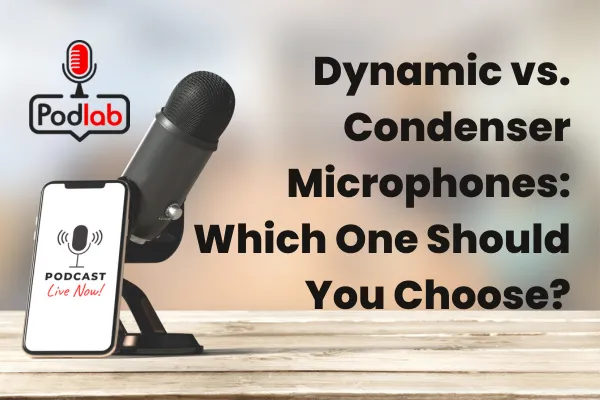PodLab Blog Posts

Dynamic vs. Condenser Microphones: Which One Should You Choose?
When it comes to selecting the right microphone for podcasting, the choice between dynamic and condenser microphones can be daunting. In this blog post, I will delve into the differences between these two popular microphone types and offer insights into why dynamic microphones are often preferred by podcasters.
Introduction to Dynamic and Condenser Microphones
As a content creator in audio production, understanding the nuances between dynamic and condenser microphones is very important. These two types of microphones cater to different recording environments and preferences, each offering unique advantages and considerations. As we navigate the realm of podcasting microphones, it's essential to weigh the benefits of dynamic and condenser microphones carefully. Understanding the nuances between these two types of microphones empowers content creators to make informed decisions based on their recording requirements and preferences.Choosing the right microphone for your recording needs involves considering various factors, such as the desired audio quality, recording environment, and personal preferences. Dynamic microphones are favored by many podcasters for their forgiving nature and ability to provide a distinct radio-like sound. On the other hand, condenser microphones excel in capturing nuanced audio details in well-treated studio settings.
Pros and Cons of Dynamic Microphones
As a podcaster looking to enhance the quality of your recordings, understanding the pros and cons of dynamic microphones is crucial. Let's delve into the benefits and limitations of dynamic microphones in various recording conditions.
Benefits of Dynamic Microphones for Podcasting
Dynamic microphones are favored by many podcasters for several reasons. One of the key advantages is their forgiving nature. These microphones are excellent at capturing rich, booming voices while effectively reducing background noise. This is particularly beneficial for podcasters who may not have access to a perfectly sound-treated recording environment.
Additionally, dynamic microphones are known for their durability and versatility. They can handle high sound pressure levels without distortion, making them ideal for capturing energetic or loud voices without compromising audio quality. Their robust construction also makes them suitable for outdoor recording or live events.
Limitations of Dynamic Microphones in Certain Recording Conditions
While dynamic microphones offer many benefits, they do have limitations, especially in certain recording conditions. One common drawback is their relatively lower sensitivity compared to condenser microphones. This means that dynamic mics may not capture subtle nuances or details in quieter recordings as effectively.
Furthermore, dynamic microphones tend to have a narrower frequency response compared to condenser mics. This can result in a less detailed and nuanced sound reproduction, which may not be ideal for capturing the full richness of certain audio sources.
Examples of Popular Dynamic Microphones Used by Renowned Podcasters
Many renowned podcasters have found success using dynamic microphones for their shows. Notable figures like Joe Rogan, Tim Ferriss, and Steven Bartlett prefer the reliability and warmth that dynamic mics bring to their recordings. For instance, the Shure SM7B is a popular choice among podcasters for its versatility and ability to perform well in various room acoustics.
While dynamic microphones may have limitations, their benefits make them a preferred choice for podcasters seeking a robust and forgiving audio capture solution. Understanding how to leverage the strengths of dynamic microphones can significantly enhance the quality of your podcast recordings.
Pros and Cons of Condenser Microphones
As a content creator passionate about audio quality, I have had the opportunity to explore the fascinating realm of condenser microphones. These devices are renowned for capturing clear, natural sound with exceptional detail and sensitivity. However, like any tool, condenser microphones come with their own advantages and challenges that are important to consider.
Advantages of Condenser Microphones
One of the condenser microphones' primary advantages lies in their ability to capture audio with remarkable clarity and accuracy. Due to their sensitive diaphragms, condenser microphones excel in capturing subtle nuances and delivering a more natural sound reproduction compared to dynamic microphones.
Furthermore, condenser microphones are ideal for recording vocals, acoustic instruments, and intricate soundscapes where precision and fidelity are paramount. Their ability to capture a wide frequency range and transient response makes them indispensable tools for professional audio production.
Challenges Associated with Condenser Microphones
Despite their exceptional audio quality, condenser microphones present challenges when used in less acoustically optimized environments. These highly sensitive microphones can pick up background noise and room reverberations, which may affect the overall recording quality.
Additionally, condenser microphones require phantom power to operate, which may limit their portability and compatibility with certain recording setups. Ensuring a well-treated studio environment is crucial when using condenser microphones to minimize unwanted noise and interference.
Comparison with Dynamic Microphones
When comparing condenser microphones with dynamic microphones in terms of audio quality, it's essential to understand the distinct characteristics of each type. Dynamic microphones are known for their durability, versatility, and ability to handle high sound pressure levels without distortion.
While dynamic microphones may lack the sensitivity of condenser microphones, they excel in rejecting background noise and delivering a robust, radio-like sound. Podcasters and broadcasters often prefer dynamic microphones for their forgiving nature and reliability in various recording environments.
Ultimately, choosing between condenser and dynamic microphones depends on your specific recording needs and preferences. If you prioritize clarity, detail, and natural sound reproduction, a condenser microphone may be ideal. On the other hand, if you require a microphone that can withstand challenging acoustic conditions and deliver a more robust sound, a dynamic microphone could better suit your requirements.
Notable Podcasters' Microphone Choices
When it comes to podcasting, the choice of microphone plays a crucial role in determining the audio quality of your content. In this section, we will delve into the microphone preferences of famous podcasters like Joe Rogan and Tim Ferriss, explore the reasons behind their selection of dynamic microphones for podcasting, and share personal experiences with using both dynamic and condenser microphones.
Insights into Microphone Preferences of Famous Podcasters
Renowned podcasters such as Joe Rogan and Tim Ferriss have established themselves as authorities in the podcasting world. Their microphone choices reflect their commitment to delivering high-quality audio to their listeners. Both Rogan and Ferriss are known for their preference for dynamic microphones over condenser ones.
Reasons Behind Selection of Dynamic Microphones for Podcasting
The decision to opt for dynamic microphones by podcasting giants like Joe Rogan and Tim Ferriss is not arbitrary. Dynamic microphones offer several benefits that align with the requirements of podcasting. These microphones are known for their durability, versatility, and ability to capture rich, warm tones while minimizing background noise.
Personal Experiences with Dynamic and Condenser Microphones
Having personally used both dynamic and condenser microphones, I can attest to the differences in their performance. Dynamic microphones, like the Shure SM7B, have been my go-to choice for podcasting due to their forgiving nature and ability to deliver a radio-like sound even in less-than-ideal recording environments.
On the other hand, condenser microphones, such as the Blue Yeti, offer a clearer and more natural audio signal but require a well-treated studio setup to shine. While condenser microphones excel in capturing intricate details of sound, they are more sensitive to background noise and may not be suitable for all recording environments.
As a podcaster, the choice between dynamic and condenser microphones boils down to your recording environment and the desired audio quality. If you prioritize a clean, crisp sound and have a well-treated recording space, a condenser microphone might be the ideal choice. However, if you value the versatility, durability, and forgiving nature of your microphone, a dynamic microphone like the Shure SM7B could be the perfect fit.
Conclusion: Choosing the Right Microphone
As we wrap up our discussion on dynamic vs condenser microphones, let's recap the key points we've covered. Dynamic microphones are favored by most podcasters for their forgiving nature and ability to reduce background noise, while condenser microphones offer a clearer and more natural audio signal but are more sensitive to background noise.
When selecting the ideal microphone for your needs, consider your recording environment and the type of audio quality you aim to achieve. If you have a well-treated studio setup and desire a clean, crisp audio signal, a condenser microphone may be the right choice. On the other hand, if you prefer a more radio-like sound and do not have the ideal recording setup, a dynamic microphone would be more suitable.
It's important to remember that the audio quality of your podcasts or recordings can greatly impact the overall listener experience. Choosing the right microphone is a crucial step in ensuring that your content is delivered in the best possible way.
TL;DR
Dynamic microphones are known for their forgiving nature and ability to capture a boomy radio voice, while condenser microphones offer a clearer, more natural signal but require a well-treated studio setup.

Navigation
Contact Us
© 2023 All Rights Reserved
Podlab.agency

